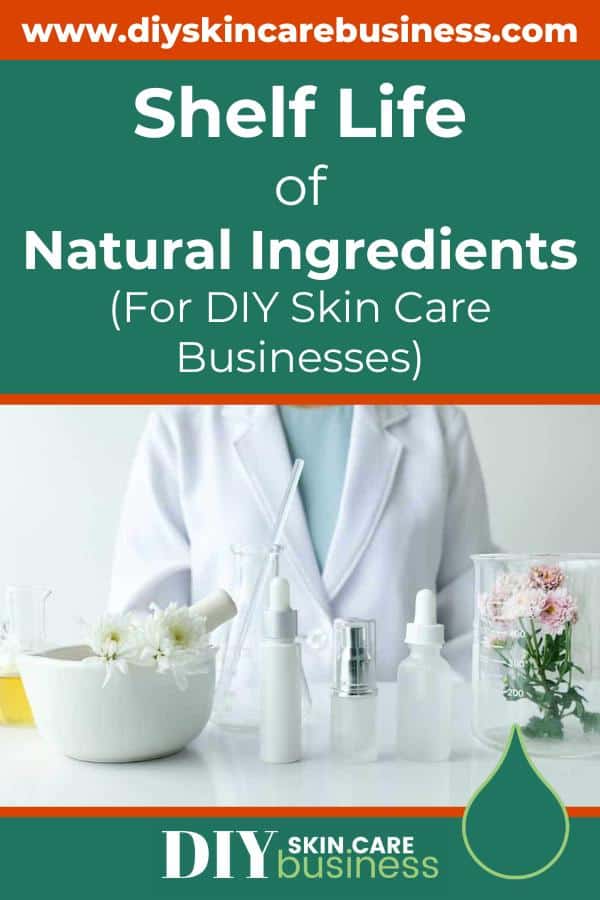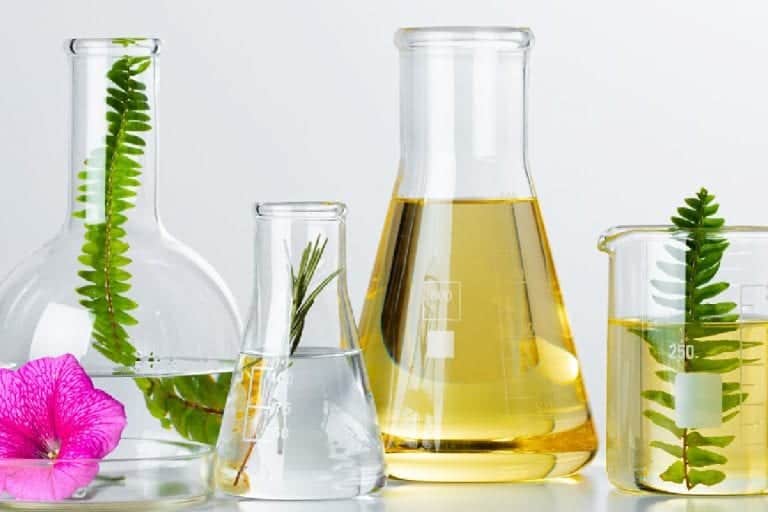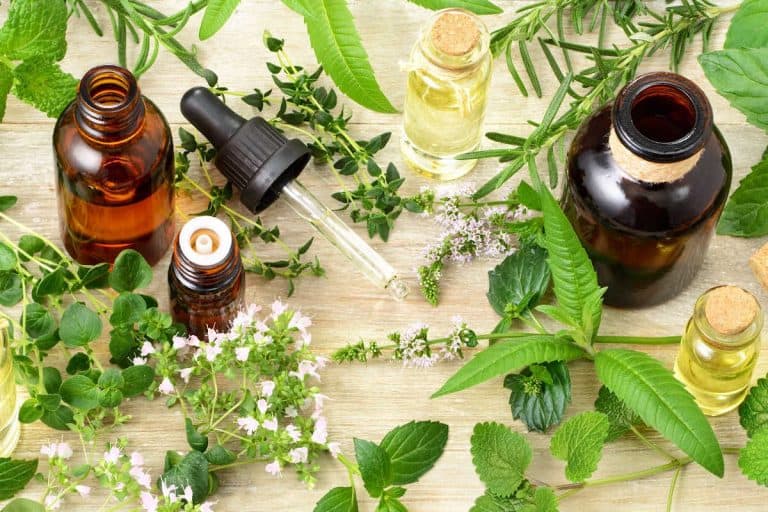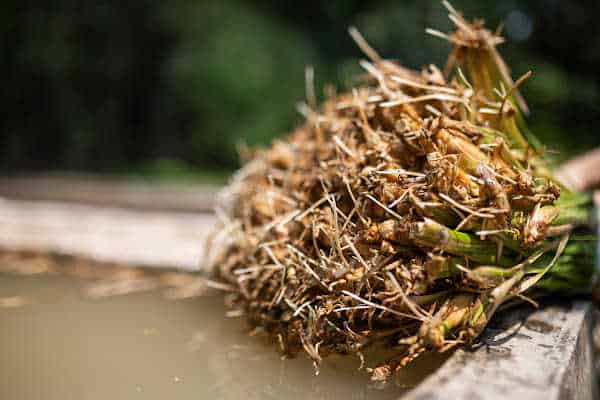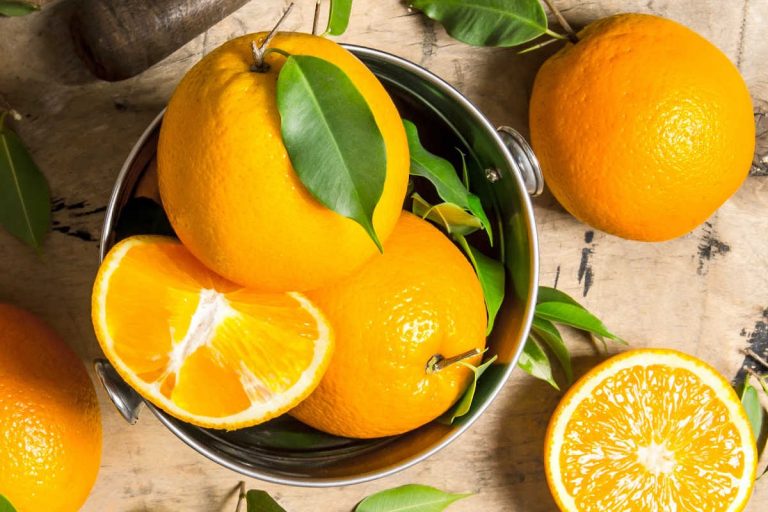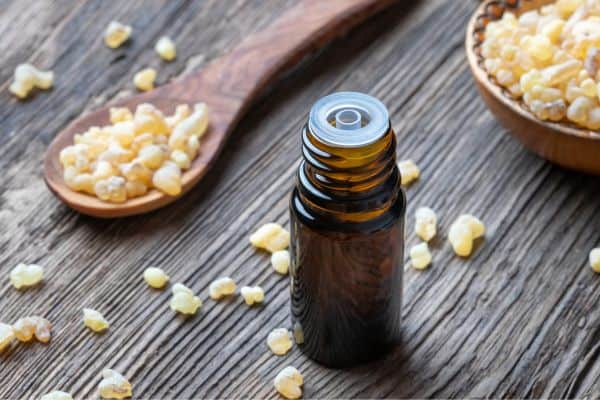As a handmade entrepreneur, there is literally nothing more important than understanding the shelf life of the natural skincare ingredients you use in your products.
When a customer purchases an item from your shop, there is an understood trust that the ingredients are fresh and will not harm their skin.
You should be able to identify the ‘use by’ date of every single skin care ingredient in your inventory so that you know they are fit for sale and have a respectable window of time to be used.
The shelf life tips and chart below will ensure you are using the safest practices for your handmade skin care business – be sure to bookmark this article for easy reference!
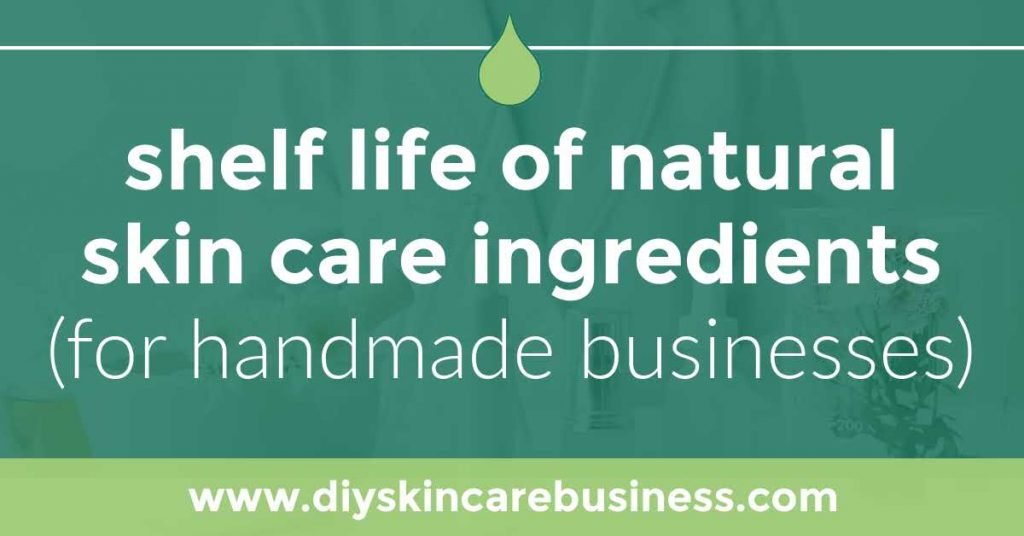
This post may contain affiliate links, meaning I get a commission if you decide to make a purchase through my links (at no cost to you). Please read the disclosure for more information.
What is ‘Shelf Life’?
Def. Shelf life/ˈSHelf ˌlīf/: The length of time an item is usable, fit for consumption, or sellable.
We’re used to seeing expiration dates on food, and most of us wouldn’t dare consume a package of beef that expired a week ago.
The same level of care and caution should go into respecting the shelf life dates of ingredients that go onto your customers’ skin.
As discussed by Gay Simmons, founder of Oh, Oh Organic, using natural ingredients means accepting a shorter shelf life for skincare products (an easy exchange for not putting chemicals onto your skin and into your bloodstream).
What Happens When a Skincare Ingredient Reaches the End of its Shelf Life?
Natural skincare ingredients vary widely in their chemical makeup and responses to oxidation, and therefore different outcomes occur when pushed past their shelf life date.
- Carrier oils can become cloudy and smell ‘off’ after their prime.
- Essential oils can lose their potency (strength of aroma).
- Butters can become grainy and result in products ‘separating’ in strange ways.
But those examples are just aesthetics.
More dangerous reactions are possible when the aged ingredients are applied to skin:
- Skin irritations
- Skin sensitization
- Rashes
- Burns
- Breakouts
As handmade sellers, it’s our job to understand these reactions and to make sure our products aren’t causing them.
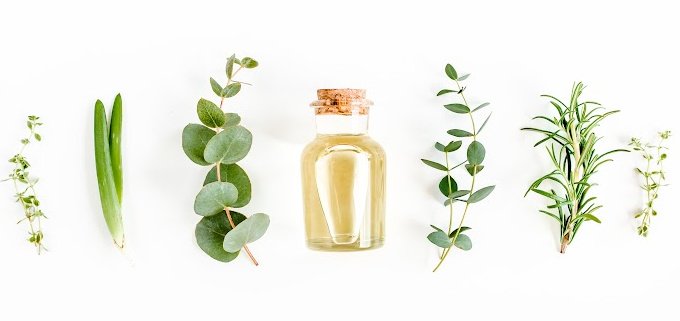
Why Understanding Shelf Life is Important for Handmade Skincare Sellers
The tricky part about being a skin care maker is that we are the ‘middle (wo)man’.
We purchase an ingredient from a supplier, have it on hand for a certain amount of time to formulate, and then pass the final product on to the consumer.
This entire time, the clock is ticking.
In fact, the countdown started as soon as the ingredient was expressed or distilled (i.e. as soon as the plant was ‘made’ into the ingredient at hand)…more on that in Tip #2 below.
The skincare products we create have more than one ingredient in them, and as handmade sellers, we need to know the shelf life of every ingredient in our recipes.
This is HUGELY important so that our customers receive products that are safe to use for a reasonable amount of time.
There are quite a few variables to consider, and the shelf life tips below will help you to keep it all straight.
KEEP SCROLLING! NEXT UP: SHELF LIFE TIPS FOR NATURAL SKINCARE INGREDIENTS
Shelf Life Tips for Your Natural Skincare Ingredients
Using natural ingredients for your skincare line requires a bit of background knowledge, but worry not – you are making the right choice to provide chemical-free products for your customers.
As long as you follow the shelf life tips below, working with natural ingredients will become second nature before you know it.
Shelf Life Tip #1: Store All Ingredients Correctly
Heat, sunlight, and air all contribute to making an ingredient oxidize (time is also a factor, but there’s nothing we can do about that!).
To ‘oxidize’ means to lose electrons, which literally changes the chemical makeup of the ingredient at hand.
We can slow that change by storing our ingredients with care. As an overarching rule, keep all of your natural skincare ingredients out of the heat, away from sunlight, and tightly sealed.
Heat:
Keep ingredients at room temperature (68 -74°F or 20-22°C). Some items require refrigeration, but that should be specifically noted by your supplier.
Sunlight:
Most natural ingredients come shipped in amber bottles (glass or BPA-free plastic) to keep out direct sunlight. Even with this protective measure, it is best practice to store your ingredients in a closet, covered with a cloth, and/or away from windows.
Air:
Keeping air away from our ingredients may sound impossible since we’re opening bottles and containers to formulate on the regular. Here are a few helpful ideas:
- Purchase carrier oils that have pumps instead of twist-off tops or disc top caps.
- Keep orifice reducers on your essential oil bottles.
- When you begin to purchase in bulk and receive larger containers, be sure to keep your smaller containers on hand as well. Use the smaller containers when you formulate, and refill with the larger quantity (this reduces the amount of headspace, aka air, in the smaller container and the number of times the larger container is opened).
Shelf Life Tip #2: Document Dates
Spoiler alert. When you purchase or receive an ingredient, that is not the start of its shelf life.
As mentioned above, the life of an ingredient begins the moment it is expressed or distilled.
If your supplier received a shipment of 200 bottles of baobab oil and is only selling a couple a week, there’s a good chance that it has been sitting on a shelf for MONTHS before coming to you.
Luckily, most reputable suppliers have batch dates/distillation dates on their products or even website listings.
If they don’t, you can absolutely reach out to them and ask for this information (if they can’t provide it, you don’t want to be purchasing from them!).
I contacted Plant Therapy about their manufacture/batch dates, and this is their setup:
“All of our products are typically made the month we sell them to [provide the longest shelf life possible]. When you receive the oil it will have a batch number. The first section is the lot number and the last 4 digits are the day it was manufactured in Julian calendar format. For example ‘1256’ would mean it was made in 2021 on the 256th day of the year.”
Now I can take that information and put it into a spreadsheet and/or write it on the cap of the ingredient.
Shelf Life Tip #3: Six-Month Window
Only purchase what you can use within six months (this amount will change as your business grows).
It’s tempting to purchase ingredients in bulk once you have some regular sales coming in. However, I encourage you to let your business purchases grow in time with your sales.
You’ll have fresher ingredients, consistent products, and more financial wiggle room – it pays off to take baby steps and be conservative with your spending when you can.
Shelf Life Tip #4: Don’t Take Chances
“If in doubt, throw it out.”
So. You’re pretty certain you’re within a safe time period for an ingredient, and then you unscrew the cap, take a whiff, and something is just…not…right.
We are doing OUR best to slow down the oxidation of ingredients by keeping them away from heat, sunlight, and air. Most reputable suppliers will do the same – but the truth is, we don’t KNOW how an ingredient is handled between the harvesting and our doorstep.
If something seems off, follow your gut and toss that sucker out (and of course contact your supplier when appropriate).
Shelf Life Tip #5: ‘Calculating’ Product Life
Throw your calculators away. This is EASY!
Your product will have the shelf life of the SHORTEST life ingredient in your recipe.
For example, if you make something with…
- Sweet Almond Oil (1-year shelf life)
- Fractionated Coconut Oil (2-year shelf life), and
- Cocoa Butter (2-year shelf life)
…your product will have the same shelf life as the Sweet Almond Oil (one year) because it has the shortest shelf life in this list of ingredients.
Bing bang boom.
Shelf Life Tip #6: Communicate with Customers
Natural products don’t last for years as other synthetic products do. And for good reason. We don’t want synthetic preservatives in our personal care products. Absolutely worth the shorter shelf life.
BUT, you need to let your customers know what the shelf life of their soon-to-be product is so that they won’t expect it to last forever like other chemical-laden versions.
You don’t want people stocking up during your Earth Day Sale for Christmas presents, only to gift a product that has gone rancid.
Make a shorter shelf life a BENEFIT (because it is!!!) … “These are all-natural products made to order without synthetic preservatives – use before XYZ date.”
KEEP SCROLLING! NEXT UP: SHELF LIFE CHART OF COMMON NATURAL SKINCARE INGREDIENTS
Shelf Life Chart of Common Natural Skincare Ingredients
*The shelf life of essential oils varies based on the chemical family that they fall under for each given batch; this will change depending on the growing conditions of the plant, how it is distilled, and other variable factors. The shortest possible shelf life (assuming ideal storage conditions) is indicated on this chart to err on the side of caution.
The shelf life approximations below assume that you are keeping your ingredients stored in a cool area, out of the light, and tightly capped (the least amount of air exposure possible to avoid oxidation).
| Ingredient | Shelf Life When Stored Correctly |
|---|---|
| Activated Charcoal (Activated Carbon) | Indefinite |
| Alkanet Root (Alkanna tinctoria) | 2 years |
| Anise Essential Oil (Pimpinella anisum) | 3 – 5 years* |
| Apricot Kernel Oil (Prunus armeniaca) | 1 year |
| Argan Oil (Argania spinosa) | 2 years |
| Avocado Oil (Persea gratissima) | 1 – 2 years |
| Baobab Oil (Adansonia digitata) | at least 2 years |
| Basil (Sweet) Essential Oil (Ocimum basilicum ct. linalool) | 3 – 5 years* |
| Beeswax (Cera alba) | Indefinite |
| Bentonite Clay (Montmorillonite) | 2 years |
| Bergamot Essential Oil (Citrus bergamia) | 1 – 3 years* |
| Black Pepper Essential Oil (Piper nigrum) | 1 – 3 years* |
| Cardamom Essential Oil (Elettaria cardamomum) | 2 – 3 years* |
| Castor Oil (Ricinus communis) | 2 years |
| Cedarwood Essential Oil (Juniperus virginiana) | 6 – 8 years* |
| Chamomile (German) Essential Oil (Matricaria recutita) | 2 – 3 years* |
| Chamomile (Roman) Essential Oil (Chamaemelum nobile) | 3 – 5 years* |
| Clary Sage Essential Oil (Salvia sclarea) | 3 – 5 years* |
| Clove Bud Essential Oil (Eugenia caryophyllata) | 3 – 5 years* |
| Cocoa Butter (Theobroma cacao) | ~ 2 years (longer if stored cold) |
| Coconut Oil (76 degree) (Cocos nucifera) | 2 years |
| Coconut Oil (Fractionated) (Cocos nucifera) | 2 years |
| Cypress Essential Oil (Cupressus sempervirens) | 1 – 3 years* |
| Eucalyptus Essential Oil (Eucalyptus globulus) | 2 – 3 years* |
| Evening Primrose Oil (Oenothera biennis) | 1 year |
| Fennel Essential Oil (Foeniculum vulgare) | 3 – 5 years* |
| Frankincense Essential Oil (Boswellia carterii) | 1 – 3 years* |
| Geranium Essential Oil (Pelargonium x asperum) | 3 – 5 years* |
| Ginger Essential Oil (Zingiber officinale) | 6 – 8 years* |
| Grapefruit Essential Oil (Citrus paradisi) | 1 – 3 years* |
| Grapeseed Oil (Vitis vinifera) | 1 year |
| Helichrysum Essential Oil (Helichrysum italicum) | 3 – 5 years* |
| Jasmine Absolute (Jasminum grandiflorum) | 3 – 5 years* |
| Jojoba Oil (Simmondsia chinensis) | Indefinite |
| Juniper Berry Essential Oil (Juniperus communis) | 1 – 3 years* |
| Laurel Leaf Essential Oil (Laurus nobilis) | 1 – 3 years* |
| Lavender Essential Oil (Lavandula angustifolia) | 3 – 5 years* |
| Lemon Essential Oil (Citrus limon) | 1 – 3 years* |
| Lemongrass Essential Oil (Cymbopogon citratus) | ~ 2 years* |
| Lye (Sodium Hydroxide) | 1 year |
| Mango Butter (Mangifera indica) | 2 years |
| Marjoram (Sweet) Essential Oil (Origanum majorana) | 1 – 3 years* |
| Melissa Essential Oil (Melissa officinalis) | ~ 2 years* |
| Menthol Crystals (Mentha arvensis) | 2 years |
| Micas | Indefinite |
| Moroccan Clay (Rhassoul) | Indefinite |
| Myrrh Essential Oil (Commiphora myrrha) | 6 – 8 years* |
| Neroli Essential Oil (Citrus aurantium var. amara) | 1 – 3 years* |
| Nutmeg Essential Oil (Myristica fragrans) | 1 – 3 years* |
| Oatmeal (Colloidal) (Avena sativa) | 1 – 2 years |
| Olive Oil (Olea europaea) | 2 years |
| Orange (Sweet) Essential Oil (Citrus sinensis) | 1 – 3 years* |
| Palm Kernel Oil (Elaeis guineensis) | 2 – 3 years |
| Palmarosa Essential Oil (Cymbopogon martinii var. motia) | 3 – 5 years* |
| Patchouli Essential Oil (Pogostemon cablin) | 6 – 8 years* |
| Peppermint Essential Oil (Mentha x piperita) | 3 – 5 years* |
| Ravintsara Essential Oil (Cinnamomum camphora ct. 1,8 cineole) | 1 – 3 years* |
| Rice Bran Oil (Oryza sativa) | 1 – 2 years |
| Rose Absolute (Rosa x damascena) | 3 – 5 years* |
| Rosehip Seed Oil (Rosa rubiginosa) | 6 – 9 months |
| Rosemary Essential Oil (Salvia rosmarinus / Rosmarinus Officinalis ct. 1,8 cineole or ct. camphor) | 1 – 3 years* |
| Sandalwood Essential Oil (Santalum album) | 6 – 8 years* |
| Shea Butter (Vitellaria paradox) | ~ 1 year |
| Sunflower Oil (Helianthus annuus) | 1 year |
| Sweet Almond Oil (Prunus dulcis) | 1 year |
| Tamanu Oil (Calopphyllum inophyllum) | ~ 4 years |
| Tea Tree Essential Oil (Melaleuca alternifolia) | 1 – 3 years* |
| Thyme (Linalool) Essential Oil (Thymus vulgaris ct. linalool) | 1 – 3 years* |
| Vetiver Essential Oil (Chrysopogon zizanioides or Vetiveria zizanioides) | 3 – 5 years* |
| Vitamin E (Tocopherol) | 2 – 3 years |
| Ylang Ylang Essential Oil (Cananga odorata var. genuina) | 3 – 5 years* |

Are You Ready to Buy Natural Skincare Ingredients in Bulk?
After you have sold your items for a while and get a sense of what products are going to be your best sellers, it may make sense to look into buying your ingredients in bulk.
Buying ingredients in bulk is great for many reasons:
- It lowers your overall inventory costs, which increases your profit margin
- It reduces the amount of packaging and transportation waste
- You’ll have plenty of resources on hand in case you get a sudden boost in sales that you hadn’t initially planned for
The prices of natural ingredients fluctuate pretty widely, as you’ll be purchasing from all over the world: West Africa, Southern California, Northwestern Mexico, etc.
The pricing is affected not just by supply and demand, but also by the oil and gas industry, as well as tariff and trade fluctuations.
Before I had kids, I used to spend hours every time I needed to replenish my inventory to make sure I was getting the best prices available.
(I applaud that well-rested and frugal version of myself.)
Time is now my most precious resource, and having specific vendors I go to for each item on my list is sooo very worth it to me.
Sometimes I get the best price anyway, sometimes I don’t – but having priced my product line to allow for variations, it’s not a worry enough for me to lose sleep about.
My preferred natural skincare ingredient vendors:
Starwest Botanicals
- Dozens of carrier oils in different quantities (small and bulk)
- A variety of beeswax and butters
- All the herbs, teas, and seeds you’d ever need
- Starwest Botanicals also carries interesting and useful natural living supplies and accessories – sea sponges, dryer sachets, and reference materials
- Tons of organic options!
Plant Therapy
- My go-to for all essential oils. They provide the GC/MS reports that show the exact percentage of constituents in every batch, so I know they are pure and unadulterated.
- They also have carrier oils and butters/waxes and I purchase from here if Starwest Botanicals is out of something.
- Plant Therapy also has quite a bit available in bulk sizes – the best quality essential oils AND the best pricing.
Be sure to save this post to your bookmarks for quick reference – send me a message if you have any other natural ingredients you’d like me to add to this list so that it’s a one-stop tool for you!
Happy formulating, my fellow skin care maker!
Grow Your Skin Care Business!
Browse through the resources below to boost your handmade business visibility and profitability!
